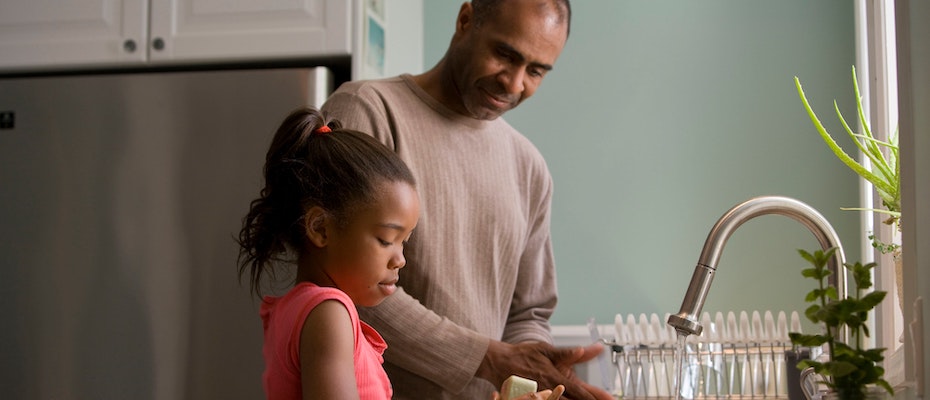Talking to children and young people about war in Ukraine

‘Children are both our reason to eliminate the worst aspects of armed conflict and our best hope of succeeding in that charge’
(Graça Machel)
The news is full of violent images, threats and foreboding. As parents, carers and educators our first thoughts are surely with the children and young people of Ukraine. Then they perhaps turn to the children in our own lives.
As much as we want to protect them from the news, to prolong the innocence and optimism of youth, there’s no bubble that can withstand the 24-hour newsreels, social media notifications and playground chatter. Seeing posts about ‘World War 3’, talk of ‘planes’, ‘tanks’ and ‘bombs’ can cause anxiety at all ages. Even younger children, like little sponges, will absorb the mood of the room and the adult-whispered conversations.
Below we suggest some ways to support children and young people when having conversations about the current conflict and war. We’re also fundraising for Unicef UK to support children and families in Ukraine, please give what you can.
Take care of yourself
Perhaps you’ve shared the emotional experiences we had when news broke about the Russian invasion of Ukraine. Shock, despair, anxiety, uncertainty. These are big emotions for anyone to feel and as adults we often have increased access to rolling news bulletins, which can only magnify some of those feelings.
Spending some time getting to grips with your own feelings and emotional reactions can be an important step towards being able to effectively support the children and young people in your life.
Perhaps you need some quiet time, or to talk with friends or other important people in your life. It can be easy to get lost in the 24 hour news cycle, or news via Twitter, so trying to keep routines that are meaningful to you can be a boost e.g. that morning walk, or eleven am coffee.
Listen to them
We can’t control everything children hear, and in the absence of the truth they will piece snippets together and create their own narrative. Open conversations will help you to deal with the exaggerations and hysteria that can develop on social media and WhatsApp groups.
Ask what they have heard and how they are feeling, and listen to their responses. Validate their feelings. None of us like to be told to calm down or to stop worrying. The feelings are real and being allowed to express them helps us feel understood. Provide a safe space for children to ask questions and share fears.
Active listening involves giving children our full attention, repeating back what they have said to ensure we understand their point of view. How we respond will obviously depend on their age and emotional maturity. Be honest but reassuring at the appropriate level. Younger kids require safety messages, while older children and adolescents tend to need facts and context.
Help them feel safe
Children need to see the world as safe and predictable. Experiences of trauma, or even images of trauma, can make the world feel an uncontrollable and unpredictable place. Look out for signs of fear or worry that they may not be willing or able to express. For example:
- being more clingy than usual
- wanting more hugs and kisses
- becoming withdrawn
- not sleeping or eating as well
- becoming angry, irritable, tense or fidgety
- complaining of tummy pain.
We can’t (and shouldn’t) hide what is happening in the world, but we can limit the exposure by monitoring internet usage (depending on age) and not having constant news in the background on tv and radio. It might help to show a map of the world to demonstrate how far away the fighting is.
Bruce Perry states that, because us humans are inescapably social beings, the worst catastrophes that we can experience are those that involve relational loss. Therefore, recovery must involve re-establishing human connections. Perry suggests that the most important healing experiences often occur outside therapy and inside homes, communities and schools.
You may be supporting children who have direct experience of war and have had to leave their home countries as a result. Much work supporting schools with refugee pupils has involved reassuring and affirming what they are already doing. School provides a secure environment with a predictable routine, clear expectations and consistent rules. Refugee children and young people who participated in a study in Ireland described education as the most important factor in enabling ongoing access to social support and enhancing resilience. They described school-related opportunities to develop social networks, create a sense of belonging, access information, and have recreational outlets.
Look out for those who might be more vulnerable
Refugee and asylum seeking pupils may have experienced trauma. This can increase the risk of psychological distress and potential social, emotional, behavioural and learning difficulties. Trauma experiences increase the risk of psychological distress and potential social, emotional, behavioural and learning difficulties. However, it is important to emphasise that not all refugee pupils will present with traumatic distress as a result of their experiences. Many display resilience, resourcefulness and high functioning despite the adversities they have encountered.
It is often the post-migration factors, related to family, peer, community, school and service provision, that can either mitigate or exacerbate mental health difficulties. Signs of trauma to look out for include:
- flashbacks
- nightmares
- re-enactment
- hypervigilance
- separation anxiety
- avoidance
- withdrawal
- aggressive behaviour
- lack of emotion
- developmental delay.
It is important to treat refugee pupils as individuals and not as a homogenous group. Often they told us that they just wanted to blend in and not be seen as any different. This may sound obvious but here are the words of one pupil in our research:
…we had to do a poster about refugees. And in my last year [teacher] asked me to go to their classroom and talk more about Syria and the refugees and things. I found it kind of hard to talk at the back, old, harmful memories. And like I actually don’t want to talk about it
We might also need to listen out for how children might understand or talk about the different people involved in the conflict. It is easy in discussions about war and conflict to draw on notions of the ‘good’ or ‘bad’ side, and sometimes these ideas can be generalised to everyday life. Children, young people and families from Russia might be particularly vulnerable right now, as might children who speak Russian i.e. those from Estonia, Latvia, Belarus, Kazakhstan, Moldova and Georgia.
Agency, play and positivity
We want to foster compassion and empathy. Helplessness and apathy are the real enemy. We all feel better when we can do something, so supporting action and agency in children is important also. You might then want to engage them in a discussion about how they could be involved in building a better, safer, kinder world. This might involve befriending the child in their class who doesn’t speak English yet; perhaps donating to a charity or bringing them to an anti-war protest.
Play is fundamental for wellbeing and holistic development (cognitive, social, emotional and physical). Children may re-enact or try to make sense of what they see on the news through their play, or perhaps through their drawing. We should encourage this where appropriate. These forms of storytelling can help them process without the need for words, with the added value of helping us to see where they are at.
Finally, we suggest trying to bring some positive perspective. We could talk about stories of reconciliation from Northern Ireland or South Africa, or consider people who have demonstrated great acts of heroism or kindness during conflict. We might discuss times when our children themselves have overcome worry or fear in their own lives. In the words of Howard Zinn:
‘If we see only the worst, it destroys our capacity to do something. If we remember those times and places – and there are so many – where people have behaved magnificently, this gives us the energy to act, and at least the possibility of sending this spinning top of a world in a different direction.’
One thing before you go. If you’re able to, we’d really appreciate if you could support our fundraising efforts for children and families in Ukraine.




[…] Extract from Talking to children and young people about war in Ukraine – edpsy.org.uk […]
Excellent article, well considered and extremely helpful. Thank you
[…] Click Here […]
Thanks so much for this. Very helpful. We’ve shared this with all the schools we work with.
Thanks Mark, really appreciate the feedback and so glad to hear that it might be helping staff have these conversations, in the schools that you work with.